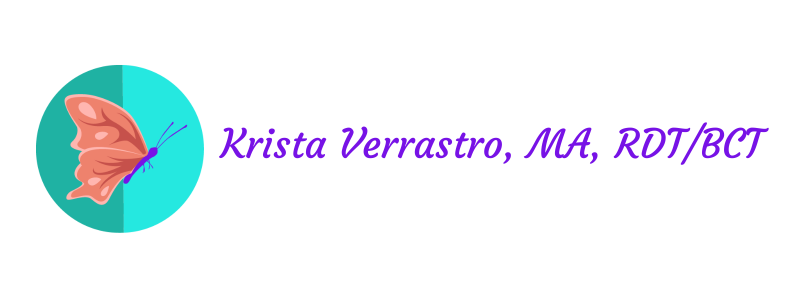
Mental health professionals, regardless of their particular degree or modality, strive to help clients with symptom relief. Traditional mental health professionals (e.g. counselors, social workers, psychologists, etc.) tend to address symptom relief through talk therapy. Creative arts therapists address symptom relief through both talk therapy and the arts. The creative arts therapies (which will be referred to as CATs for the rest of this article), therefore, provide more opportunities for symptom relief.
The CATs are considered holistic therapies because they address what are considered to be the five domains of health: emotional, physical, cognitive, social, and spiritual health.
Emotional Benefits
The CATs:
• Improve mood. Studies show that creativity boosts neurotransmitters, which are chemicals in the brain that impact mood. Creativity appears to particularly increase the neurotransmitters that activate the reward system in the brain, therefore giving people a sense of pleasure.
• Allow for more ways of expression than talk therapy. They help express experiences that are too difficult to put into words.
• Provide catharsis. They allow for more of a full release of distressing feelings by transforming feelings from mere mental concepts to tangible ones. For example, one may feel more relieved after painting a picture of a storm that represents their depression than if they were to solely talk about their depression. Another example is a person feeling more relieved after they role-play unfinished business they have with someone than if they just talked about feeling unresolved.
• Tend to be more engaging than talk therapy. Exploring issues through the arts often feels more fun and lighthearted than talking about them, even when distressing thoughts and feelings are explored.
• Allow distressing feelings to be explored at a safe distance. Talking does not necessarily help make distressing feelings more manageable when they feel out of control, but using metaphors usually does. An example of this is having a client use an imaginary container or create a container to pretend to put distressing feelings into. Using objects, such as dolls or puppets, or creating characters also helps explore distressing emotions in ways that feel safer. When exploring feelings through objects or characters, it feels safer since one is not directly talking about oneself.
• Provide opportunities for new perspectives and insights. By externalizing one’s issues through objects and characters, one is better able to view their issues objectively. For instance, someone exploring anger through a character they created may realize some aspects of their anger that they would not realize solely through talking about it.
• Help people feel that they are being active in dealing with problems. The experiential nature of the CATs helps people feel more proactive than talking does.
• Increase self-esteem, confidence, and empowerment. People often feel a sense of accomplishment when being creative and expressing themselves. These feelings are also increased through the mastery and control people experience through participation in the arts.
• Provide structure, predictability, and stability. Because the arts transform mental concepts into concrete items, they provide a greater sense of stability than talking does. The rituals that can be used in the CATs, especially at the beginnings and endings of sessions, also provide a sense of these things.
Physical Benefits
The CATs:
• Help people be more present and comfortable in their bodies. By including the body in therapy, the CATs address the mind-body connection.
• Relieve stress. Studies show that creativity relieves stress in much the same ways that meditation and yoga do.
• Reduce pain and illness. Studies show that creativity helps regulate the amygdala and hypothalamus. These parts of the brain control the immune system, the body’s inflammatory response, and mood and hormone regulation. Therefore, regulating these parts leads to decreased issues with immunity, inflammation, moods, and hormones.
• Help regulate breathing, heart rate, and digestion. Including the body in therapy, especially through repetition and rhythm, helps soothe parts of the brain and body that affect these functions.
• Strengthen motor skills. Using art, dance, drama, music, and writing in therapy allow opportunities for the strengthening of motor skills.
Cognitive Benefits
The CATs:
• Help brain functioning. Studies show that creativity promotes the production of neurons, improves communication between parts of the brain, and increases cognitive functioning overall (including memory recall, problem solving, and focus).
• Help with problem solving. As mentioned above, creative methods provide more opportunities to see problems in a more objective way and to find new perspectives on how to deal with them.
• Increase spontaneity and flexibility. Improvising during creative activities helps people be more comfortable with spontaneity and flexibility, which are important life skills.
• Help process trauma memories and non-verbal memories. Studies show that these types of memories are accessed and processed more easily and thoroughly through non-verbal therapies.
Social Benefits
The CATs:
• Provide more opportunities for communication than talk therapy. Again, including the body and creativity in therapy provides other ways of communicating besides talking.
• Build and strengthen connections among people. Some examples of how they do this include: a person feeling witnessed after creating artwork, isolation being decreased through shared creation, and trust being built through shared creation.
• Promote empathy. They do so through shared creations and the taking on of new perspectives, such as through role play.
• Provide a safe space to re-enact and heal trauma experiences. Because the CATs often feel more engaging and more emotionally safe for the aforementioned reasons, they provide a safe space to explore trauma.
Spiritual Benefits
The CATs:
• Provide more opportunities for self-expression, self-reflection, and self-awareness. In addition to the above information about the CATs improving self-esteem, fMRI studies have shown that the parts of the brain responsible for self-monitoring and self-criticism are less active during creative expression.
• Help people make meaning and sacredness. They do so in various ways, such as by incorporating the body through use of rituals and focusing on awe and gratitude. For example, rather than merely talking about an experience that caused a person to feel awe, a drama therapist might ask them to act out the experience so that the person can fully embody the feelings.
• Help people feel fulfilled. As mentioned above, the process of creation helps people feel empowered and accomplished.
Contact me
Feel free to contact me if you are interested in receiving these types of opportunities for healing through drama therapy and are in the Reisterstown/Baltimore area. Also, feel free to comment below if you’ve participated in creative arts therapies and have had any of the positive experiences mentioned!
*This article originally appeared on the Psychology Arts website, which is no longer active.
